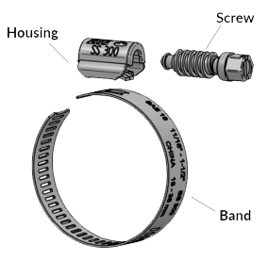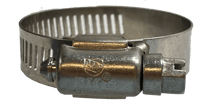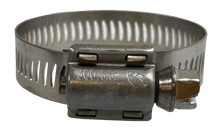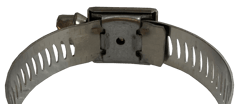
- +86 18120750932
- colin@xmsinuowei.com
- www.xmsinuowei.com

Gear clamps. A simple product, right? The short answer is yes. The long answer begs the question, what about them makes them simple and trustworthy?
Not all gear clamps are designed and manufactured in the same way, making you wonder what are the differences and how does that effect the performance?
We will cover two common construction types; 3 piece and 4 piece interlocking system designed gear clamps and their strength and weaknesses, the different series available, we will debunk a common misconception and conclude with our Quality Assurance testing.
First, let's start with what exactly a gear clamp is, just to give us a refresher.
What is a Gear Clamp?
Commonly, gear clamps are referred to as worm clamps or hose clamps. We will refer to them as gear clamps. Gear clamps are commonly used to fasten polyethylene (PE) pipe, made to standard ASTM-D2239 (Inside diameter controlled PE pipe). They are also used to secure a wide range of hoses to hose fittings such as combination nipples and hose menders.

The screw rotates in the housing, which converts the movement to a linear motion, allowing the clamp band to open and close. The components of gear clamps are:
l band
l housing (saddle piece)
l screw
The housing component holds the screw in full engagement with the slotted band. When the screw is turned, threads of the screw engage in the slots, pulling on the band to close (tighten) or push open (loosen).
Clamps can be commonly found in plumbing applications, but can also be found in the automotive, water well and HVAC industries. Plumbers frequently use clamps to fasten flexible rubber couplings (FRC) to pipe and to clamp polyethylene pipe. Tightening the screw causes compression, securely fastening pipe, hose and flexible HVAC ducts, creating a positive seal.
As mentioned above, clamps can be found either with a 3 piece interlocking system or 4 piece interlocking system, but what is the main difference?
3 Piece vs 4 Piece Interlocking System
Torque testing is used to see how much force can be applied to the band when tightening the screw, before it breaks. Under the SAE standard, clamps are required to achieve 50-lbs/inch before breaking. As a reference, the average torque someone could apply with a standard nut driver is roughly 40 to 45-lbs/inch. Clamps are often installed using power tools that are capable of much more than that. Let's take a look at why we believe one design is stronger than the other.
Caution: When using power tools, ensure the speed is low and be cautious not to over torque. Standard or impact drills used at high speeds are capable of torque upwards of 60-lbs/inch, which should be avoided. Extreme speed can result in galling (cold welding) of the stainless components and high torque will strip the band, voiding the warranty.
3 Piece Interlocking System

The housings on the 3 piece interlocking system attaches right to the band. In the picture, you can see that the housing wraps around the band and interlocks through the band on the inside. The tabs of the housing on the 3 piece design curl under the band, ensuring that when the clamp is tightened, the housing tabs get held between the pipe and the band.

The tighter the clamp, the tighter the housing is being clamped to the band and the more secure the interlock becomes. Due to this, The 3 piece interlocking system can get a higher torque rating.
You may come across a 3 piece design where the housing is spot welded to the band, however, this is a far less common manufacturing method so we will not go into detail.
4 Piece Interlocking System

The 4 piece interlocking designs housing is built up of two separate pieces: the housing and the saddle. This introduces an additional failure point. The saddle sits underneath the band, holding the housing using four tabs. The housing is held together mechanically by forming the four outward facing tabs to hold the two pieces together. Since the tabs are on the outside of the band, the greater torque is applied creating greater force that is transferred onto the four locking tabs. Since there is nothing keeping the bands from bending, the result is a very slight separation of the two housing pieces, decreasing the force.

If that happens, the housing will push away as far as it can from the band, meaning that the screw will lose some engagement with the band slots. This increases the chance of the clamp stripping and why it is believed that the maximum torque is rated lower than that of the 3 piece interlocking system.
Source:BOSHARTU

Service online